Featured Partner
Bluevine Business Checking
Annual Percentage Yield
2.0%
Minimum Deposit Requirement
$0
Monthly Maintenance Fee
$0 Waivable
UP TO $2,000 PER HIRE
GET YOUR FREE QUOTE HERE Get A Free Quote from the best cost-effective solution.![]() Best Value
Best Value
LPWriters.com is a professional LinkedIn service provider that specializes in writing effective LinkedIn bios and ensuring that you rank higher in LinkedIn searches. They can give entire profile makeover services that will help you land a job in whichever field you’d like to target.They have a host of industry awards and certifications, including certifications from LinkedIn and over 15 years of experience in writing LinkedIn profiles and improving their design. This company hires professional profile writers who will also review your LinkedIn profile for free.
LP Writers is the best LinkedIn writing service for its value. We chose this resume and LinkedIn profile writing service because they offer a free review of your profile, with no commitment to purchase any profile writing packages. This free review comprises an assessment of your keywords and SEO use, whether or not your content is suitable for your career level, and if your profile truly allows you to stand out to recruiters and hiring managers.
This is a service that most other companies don’t offer before payment. This company also offers a host of free resources all about LinkedIn profiles and different tips to make your LinkedIn the best representation of your experience and skills. If you’ve decided that you want to use their professional profile writers, their prices for a full package start at $299.
![]() Best for Profiles for Executives
Best for Profiles for Executives
Super Star Resume is a full service LinkedIn profile & resume writing company. Their writers are able to offer not just LinkedIn profile writing, but also cover letters, resumes, professional bios, and interview preparation. This company is headed by Steven Mostyn, who is a world-leading expert in job hunting strategies. Their clients have landed jobs at leading firms such as Amazon, Bank of America, Oracle, Disney, and more. We chose Super Star Resume as the LinkedIn writing service with the best service for executives. With an impressive clientele list of professionals and executives who have applied to (and been offered jobs with) well-known companies, Super Star Resume is the perfect LinkedIn profile writing service for CEOs, COOs, and anyone who is aiming to land a C-Suite role. This service can use their expertise and years of writing experience to optimize your LinkedIn profile for the executive roles you want to be noticed for. Best of all, this service offers unlimited rewrites with their packages. Their job tools are the most effective way to tailor your profile for executive leadership roles.
![]() Best for Career Changes
Best for Career Changes
Sometimes, you want a bit of a job or career shift. This can be a simple shift from a management role to a senior leadership position, or a more radical shift from one field to another.
Regardless of where you want to go, or how you want to specifically tailor your job search, a great LinkedIn writing service will be able to help you get noticed by the companies, positions, and fields you’re looking to break into.
Overseeing and helping you with a career change is no simple task, so we had to research to find out which LinkedIn profile writing service was best for people looking to switch things up. We landed on ZipJob, which is another full service resume and profile writing company. ZipJob employs over 100 different certified resume writers – therefore, it’s no surprise that this company has people in almost every industry. With ZipJob, you’re able to access the expertise of a host of different industry professionals and writers.
This is what makes this company unique and especially suited to anyone switching careers. Their writers are well-versed in keyword optimization and how to get your profile and resume noticed, even with applicant tracking system (ATS) technology. They have examples available on their website and their pricing for packages including a LinkedIn profile update starts at $299.
![]() Best for Quick Results
Best for Quick Results
The Resume Writers have been in business since 1999, when they were founded as a network of independently contracted resume writers. Much like ZipJob, the Resume Writers has many different certified LinkedIn profile writers who come from a variety of industries and backgrounds. They attempt to match you with the appropriate writer for your desired job and field – if you’re unsatisfied with their expertise, they offer to refund your order and match you with a writer better suited to your needs.
For their LinkedIn profile writing services, the Resume Writers offer a free consultation to discuss the options available to you. With their different writing packages, they offer a guaranteed 72-hour turnaround time. This is why we selected the Resume Writers as the best LinkedIn writing service for quick results. They also have an interview guarantee that makes working with them an easy decision. Their packages offer many different services, but their LinkedIn profile writing service starts at $199.
![]() Best for Lorem ipsum
Best for Lorem ipsum
No maintenance fee – $4.95 per cash deposit
Earn up to 1.5% APY
Funds available with a click, no opening or prepayment fees
Deposit cash and checks at Green Dot locations
Business hours phone support; email, chat, and support docs
![]() Best for Lorem ipsum
Best for Lorem ipsum
$50 required to open
Earn 0% APY
No lending options
Free ATM access, discounts to some software
Business hours phone support; support docs
![]() Best for Lorem ipsum
Best for Lorem ipsum
$50 required to open
Earn 0% APY
No lending options
Free ATM access, discounts to some software
Business hours phone support; support docs
| Year | Initial Balance | Interest | Principal | End Balance |
|---|
add new calculator widget
In the first 30 years, you will save: -$136,490.07
Monthly payment savings breakdown:
| CURRENT | NEW | SAVINGS | ||
| $1,633.50 | – | $1,340.06 | = | +$293.44 |
Cash Saving: -$136K
| Original loan | New Loan | |||
| Closing costs | — | $7k | ||
| Principal | $230K | $230K | ||
| Interest | $123K | $252K | ||
| Cash savings | $353K | – | $489K |
Difference in principal paid: $0K
| Original principal paid to this point | New principal paid to this point | Difference in principal paid | ||
| $230K | – | $230K | = | $0K |
Total Savings: -$136K
| Cash savings | Difference in equity | Total savings | ||
| -$136K | + | $0K | = | -$136K |
Nearly 78 million Americans volunteered their time for an organization in 2019—that’s about 30% of the population—according to AmeriCorps. Nonprofit organizations and other companies that rely on volunteers should be developing and managing volunteer programs that benefit the organization and volunteers. It all starts with a well-designed plan.
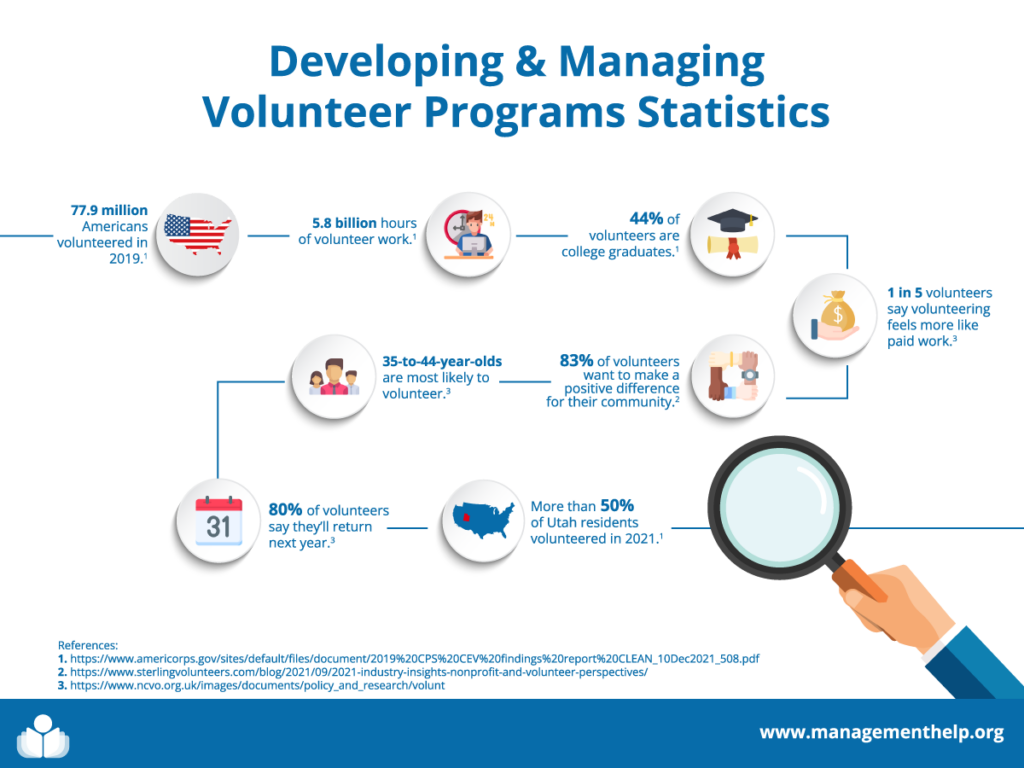
This Library topic is called “Developing & Managing Volunteer Programs” to emphasize that, for the organization and its volunteers to benefit the most from each other, volunteers should
be managed as part of an overall, systematic program, somewhat similar to the systematic approach that should be used to managing employees. Certainly, there are differences between how employees and volunteers are managed, but the differences are probably much less than most people realize.
The following links are to sections in this overall topic and the sections are organized in the order in which they might be needed in an organization that is starting a volunteer management
program—the order of the links themselves suggest the systematic nature of a well-designed volunteer management program. Organizations that already have established programs can use this overall topic by going directly to the sections that are relevant to current priorities in their current program. The links below present a wide variety of perspectives and materials about volunteer management programs or systems.
Also consider
In addition to the articles on this current page, also see the following blogs that have posts related to Volunteers and Volunteer Programs. Scan down the blog’s page to see various posts. Also, see the section “Recent Blog Posts” in the sidebar of the blog or click on “next” near the bottom of a post in the blog. The blog also links to numerous free related resources.
Any organization that develops a volunteer program should first identify the difference between a volunteer and an employee and then create appropriate boundaries. A company should also take into consideration what a volunteer wants or needs out of their experience. According to a study by Sterling Volunteers, 83% of volunteers want to make a positive impact on their community, but volunteers can get even more from their time and effort.
Recruiting volunteers is also a crucial part of developing and managing a volunteer system. There are plenty of online resources that can help you find micro-volunteering individuals or long-term volunteers. In fact, 80% of volunteers plan to give their time again to an organization they believe in, according to an NCVO survey.
Note that the extent to which an organization develops and implements a volunteer management system depends on the nature of the activities to be conducted by the volunteers. For example, an organization that uses many volunteers, some of whom directly serve people, will probably use a very comprehensive system. In contrast, an organization that occasionally uses volunteers to stuff envelopes might do a brief solicitation to recruit any volunteers that the organization can get and then do a very brief training, afterward leaving the volunteers alone to perform their task.
The primary role of the volunteer manager is to establish and operate the volunteer management system. This leader is also responsible for mediating and advocating for volunteers when necessary. Susan Ellis was one of the strongest advocates for volunteer programs and, specifically, volunteer managers. Learn more about the role of volunteer managers in her content below.
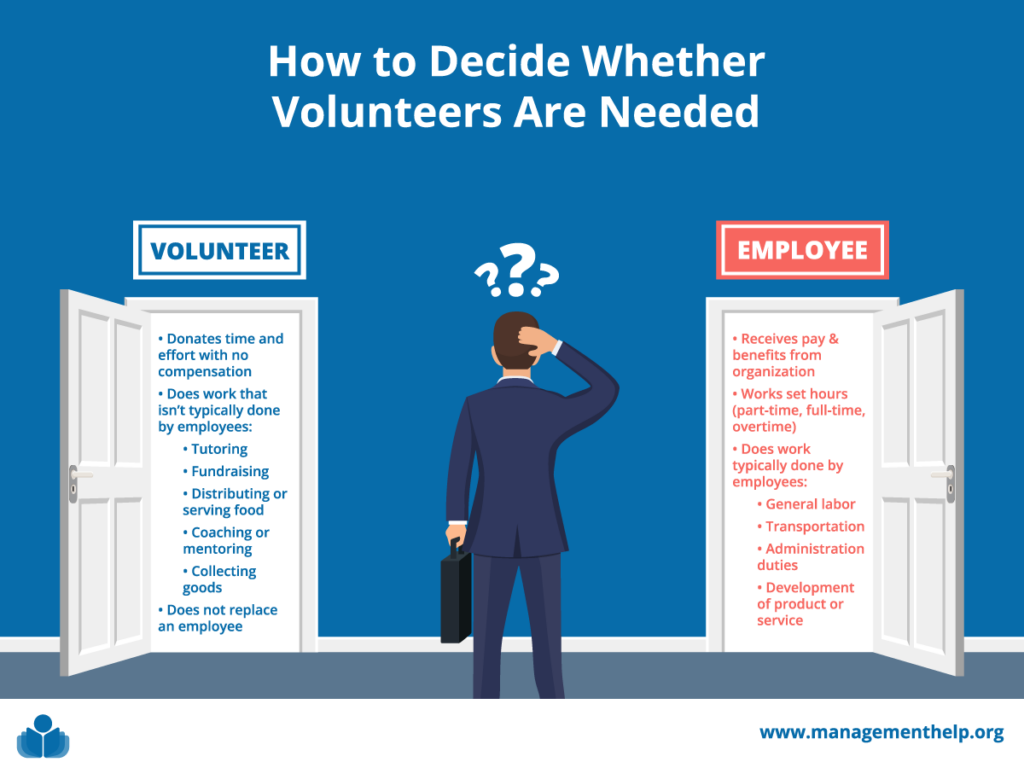
Also consider the topic for employees: Workforce planning (including succession planning)
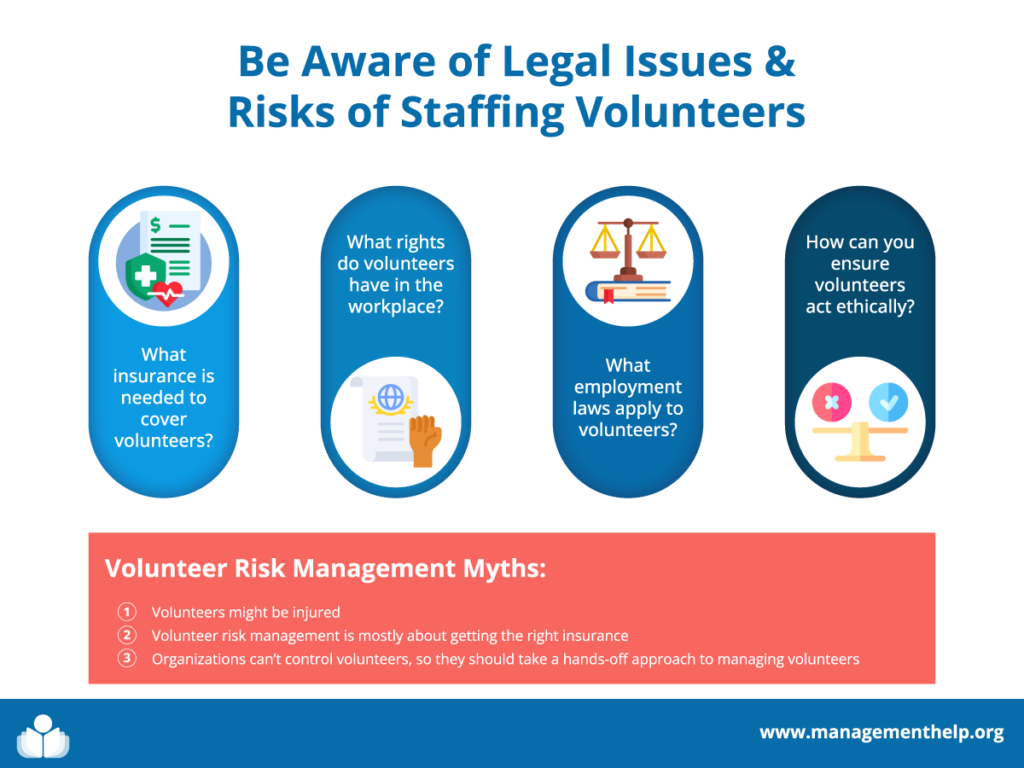
There are a variety of types of legal and risk considerations when using volunteers in an organization, e.g., what insurance is needed, what rights volunteers have in the workplace, what employment laws also apply to volunteers, and how can you ensure that volunteers act ethically, etc. The reader will get a more clear understanding of legal and risk considerations by reading the topics in the following section about management policies and procedures.
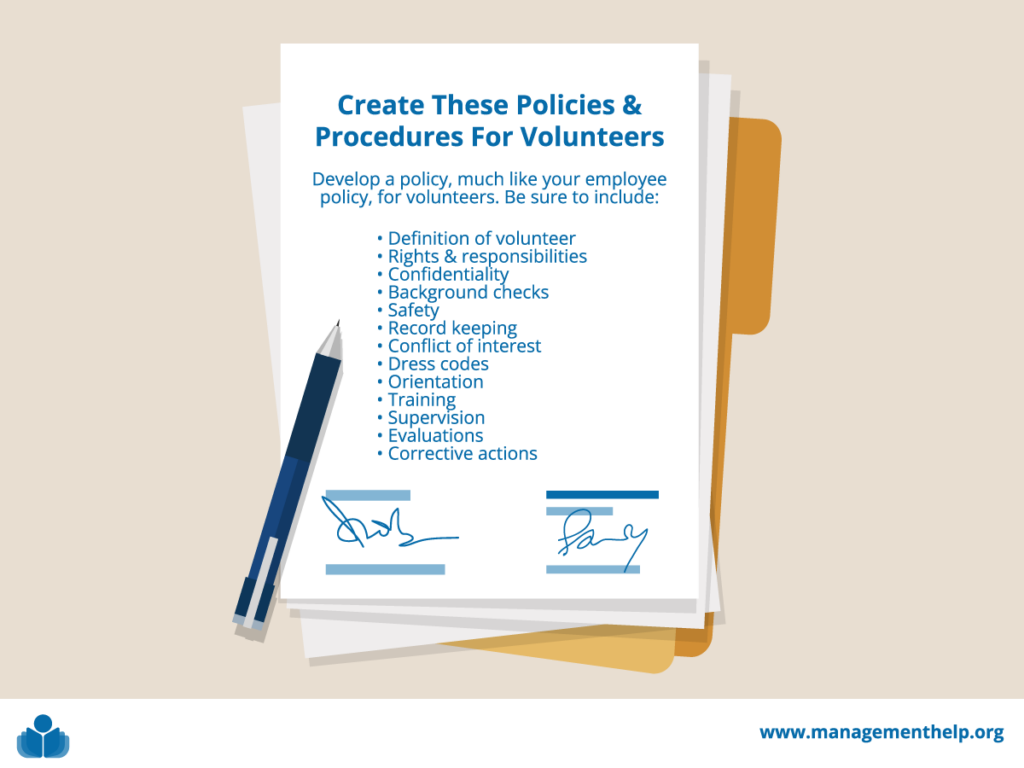
Policies are general guidelines that personnel can reference in order to make decisions and get guidance on how to act in certain situations, e.g., a policy about dress codes. Procedures are specific step-by-step directions regarding the completion of a specific task, e.g., powering up a computer. Policies help ensure that volunteers are supervised and that they act according to a legal, ethical and organizationally-preferred manner in the workplace.
Policies are often in regard to, e.g., the definition of volunteer, rights and responsibilities, confidentiality, background checks, safety, record-keeping, conflict-of-interest, dress codes, orientation, training, supervision, evaluations, corrective actions, etc.
The astute reader will recognize that the policies in regard to volunteers are very similar in nature to the policies for employees.
You should be clear about what you expect from each of your volunteers. Volunteers deserve to know what you expect from them, as well. To recruit volunteers for a specific role or job, you will need a clear job description from which to develop the advertisements and to show them to any potential candidates. Therefore, each volunteer should have a job, or task, description.
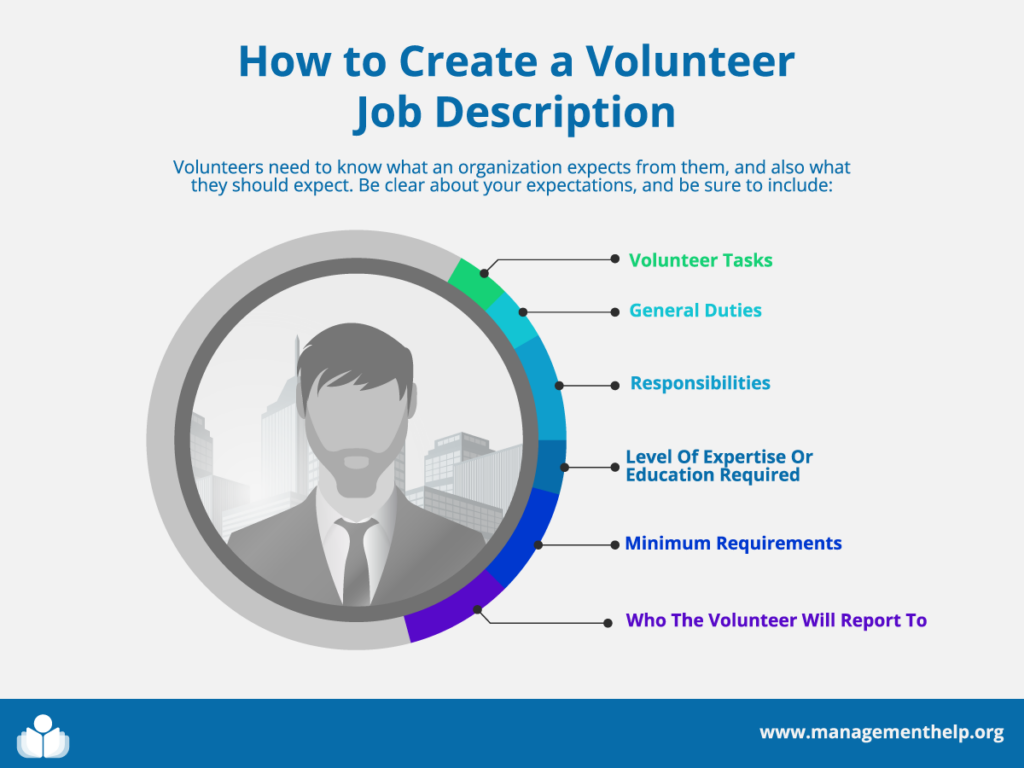
The description should specify at least whom the volunteer reports to, any general duties and responsibilities, and any specific tasks to perform. Job descriptions might include additional information, e.g., level of expertise and education needed for the job, minimum requirements of expertise, etc.
Also consider the topic for employees: Specifying Jobs and Roles (analysis, description, and competencies)
Also consider the topic for employees: Job Descriptions
Recruitment usually involves identifying the most likely sources of suitable candidates for volunteer positions, how to approach those sources, and then approaching each source. Sources might include, eg, advertisements in the newspaper, word-of-mouth of employees, recommendations from clients, online (or virtual) sources, professional placement advisors (“headhunters”), volunteer fairs (events in which many organizations that need volunteers attend to recruit volunteers), etc.
Candidates who are interested in certain positions often complete an application form, including providing a resume.
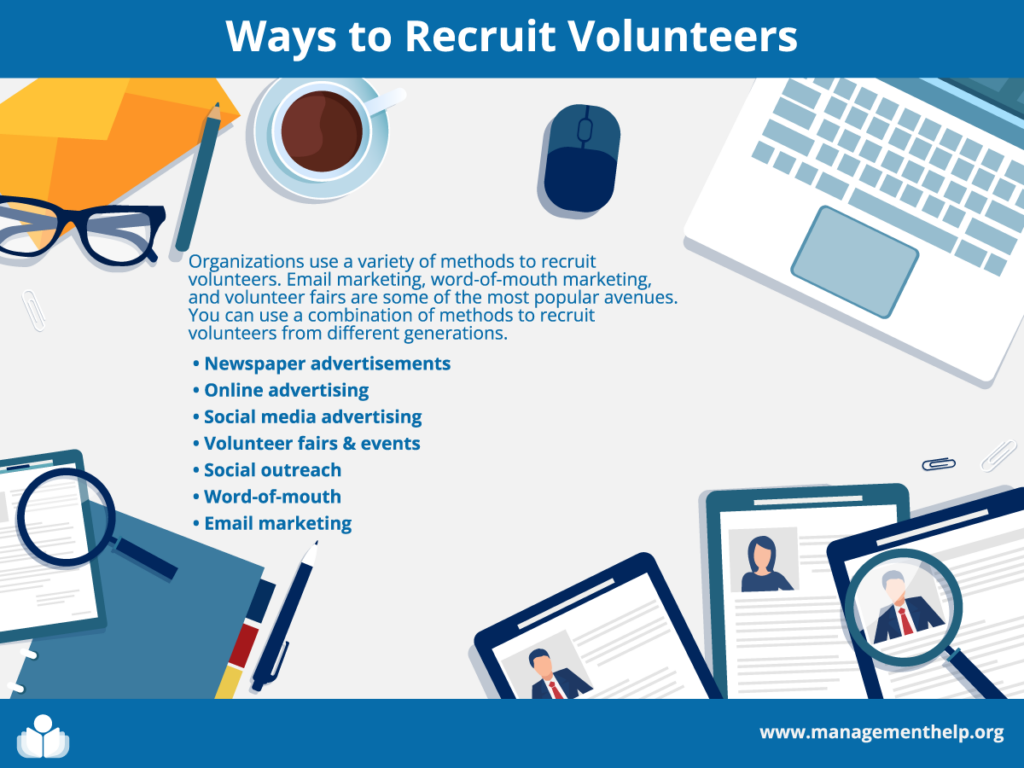
Each potential candidate for a volunteer position is usually screened. The extent of screening for each position depends on the nature of the tasks to be performed by the volunteer, e.g.,
whether the volunteer will be working directly with people in a health facility, etc. Screening often involves carefully examining each application, conducting background checks (e.g., to verify
information in the resume, identify any legal problems, etc.), and interviewing the most suitable candidates.

Also consider the topic for employees: Screening Applicants
Also consider the topic for employees: Interviews
After candidates have been screened, ideally there is one candidate that seems to be the most suitable for each unfilled volunteer position. Each suitable candidate should be formally (or officially) approached with an offer letter that describes the terms that the organization is offering and the activities that the organization wants the volunteer to conduct. The offer might include any benefits, e.g., free training, use of facilities for private use, etc.
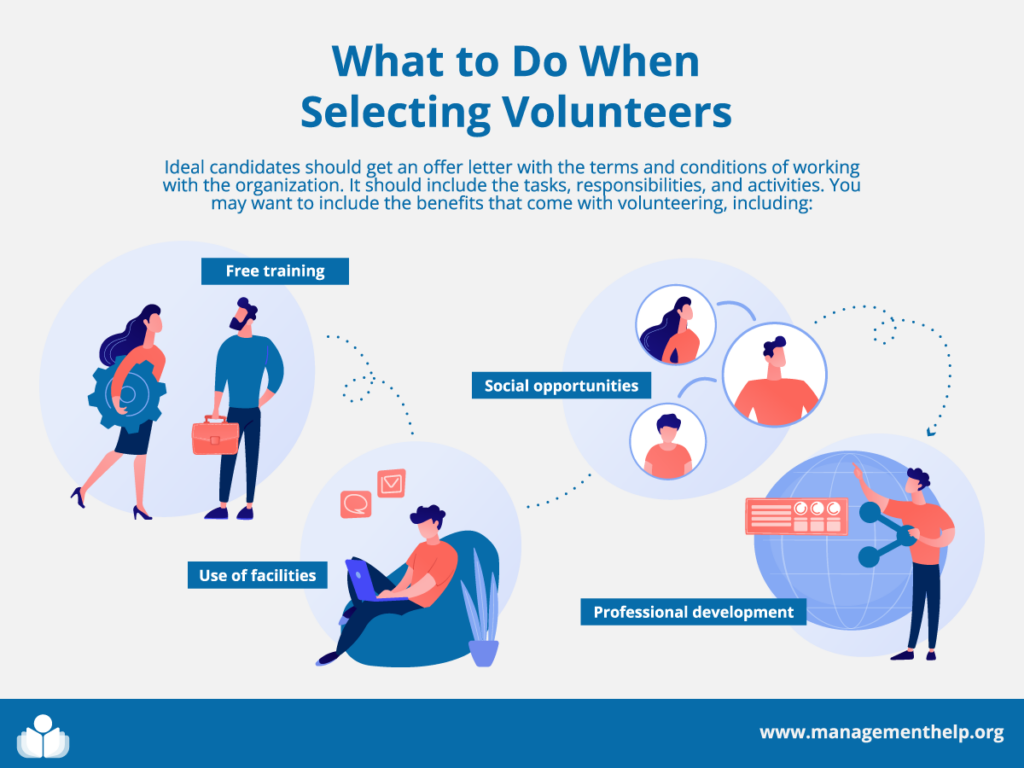
Also consider the topic for employees: Selecting (Hiring) New Employees
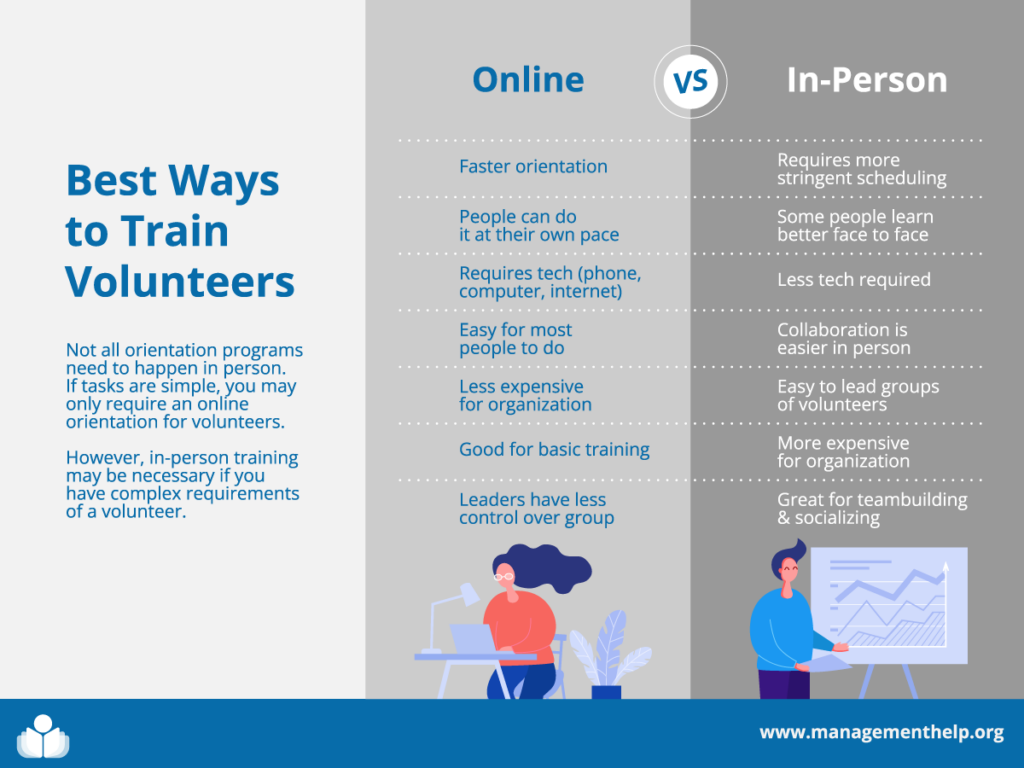
If the nature of the volunteer’s work is very basic and routine, then a volunteer might require only a very basic and general introduction to the organization and the task they are to complete. In contrast, if the nature of the volunteer’s work is rather complex, e.g., supervising patients in a particular setting in a health facility, then the volunteer will likely require a complex orientation to the organization and also training about, e.g., policies and procedures, how to respond to particular situations, when to ask for help, how to use certain facilities, etc.
If it’s a simple orientation, consider creating a volunteer training program online. Volunteers can complete the orientation in their own time at home, and then they’ll be prepared to get to work with your organization when they show up for their first day.
Also consider the topic for employees: Employee Orientation Programs
Also consider the topic for employees: Training Basics for Supervisors and Learners
Supervision includes a variety of activities, e.g., establishing goals with the volunteer, observing the volunteer’s activities to achieve the goals, and providing guidance so the volunteer achieves
the goals effectively and efficiently (i.e., has strong “performance”), evaluate the volunteer’s performance, reward strong performance, address any performance issues, and fire the volunteer, if necessary. Some supervisors are also closely involved in staffing analysis, development of job descriptions, recruiting, selecting, orienting, and training, as well.
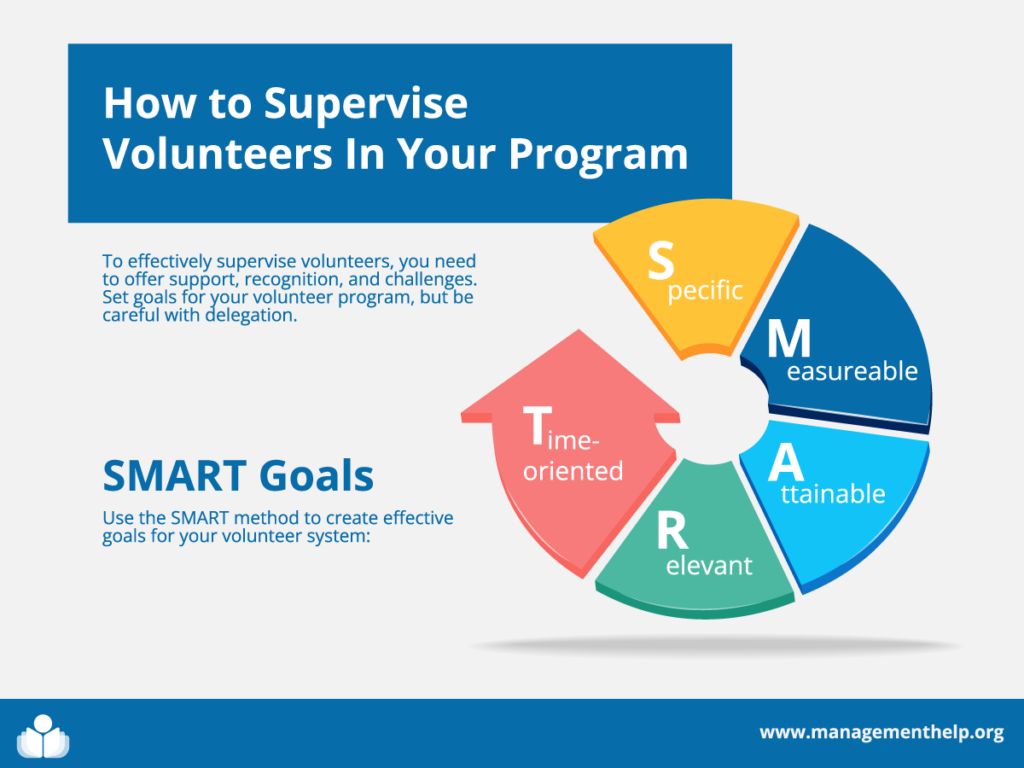
The activities to establish goals and provide guidance are usually considered to be the activities
of delegation. If the goals are specifically assigned to the volunteer, with little or no involvement from the volunteer, and the supervisor closely watches the volunteer (rather than generally guides them) and provides specific directions, then those activities might more aptly be described as work directing, rather than delegating.
Also consider the topic for employees: Delegating
Also, consider the topic for employees: Establishing Performance Goals
Also, consider the topic for employees: Retaining Employees
Also consider the topic for employees: Observation and Feedback
Also consider the topic for employees: Coaching
Also consider the topic for employees: Morale (Boosting)
Also consider the topic for employees: Motivating
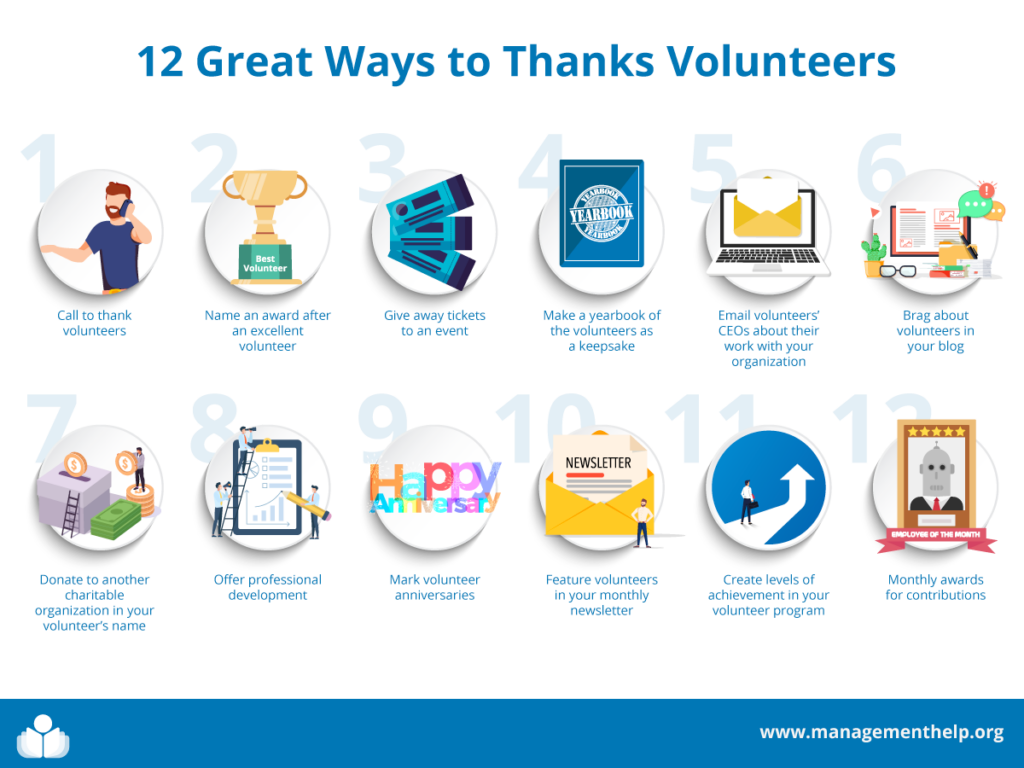
Also consider the topic for employees: Evaluating Performance
Also consider the topic for employees: Rewarding Performance
Also consider the topic for employees: Performance Plans
Also consider the topic for employees: Recognizing Performance Problems (“Performance Gaps”)
Also consider the topic for employees: Performance Improvement / Development Plans
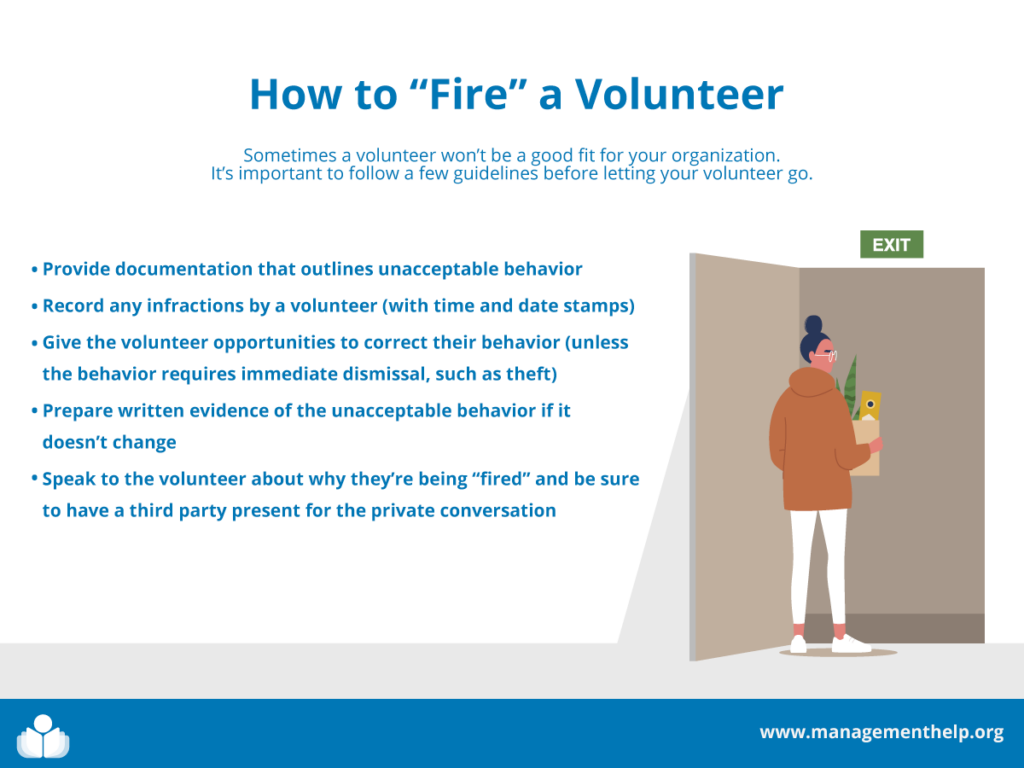
Also consider the topic for employees: Firing Employees
Sometimes employees and volunteers can perceive themselves to be so different from each other that they spend little time together, don’t communicate with each other, and eventually experience conflict between each other.
To ensure that the volunteer management system remains high-quality, including that the organization and its volunteers are benefiting a great deal from their relationship, it’s necessary to regularly assess the quality of each activity (eg, developing job descriptions, recruiting, training, supervising, etc.) to conclude if the activity is being conducted effectively and efficiently. Results of this overall evaluation should be used to adjust activities. Thus, the cycle of the volunteer management system starts over again.
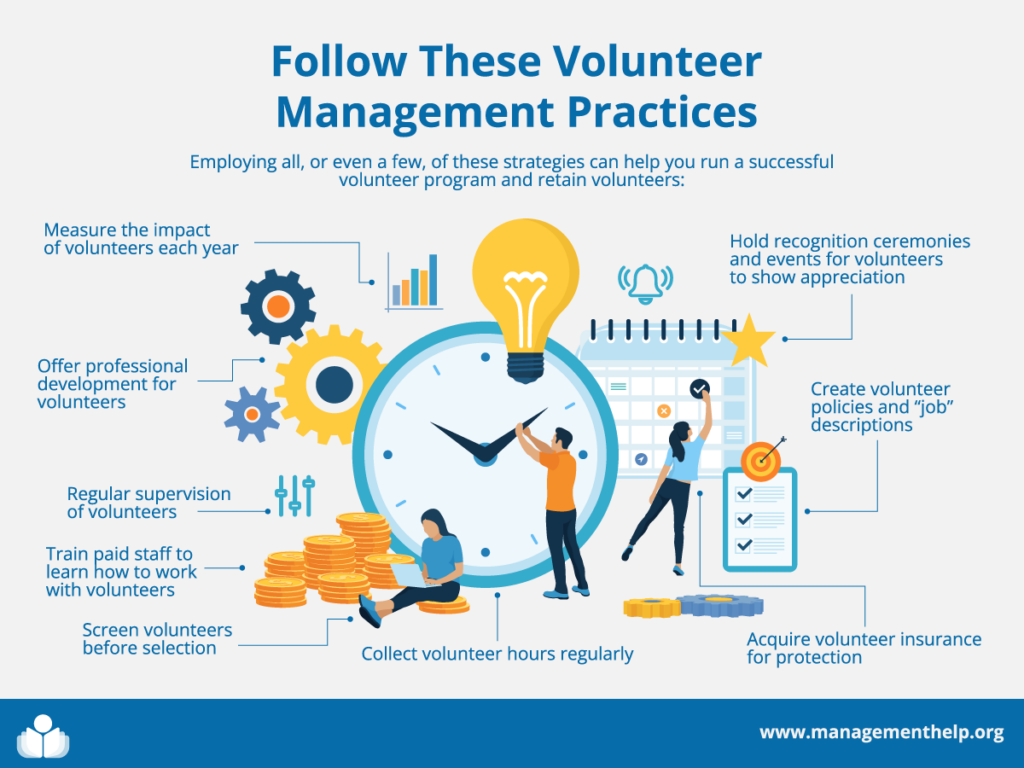
Virtual volunteering is when the volunteer provides their donated services entirely over the internet or from a home computer. Information about virtual volunteering can be about the entire range of activities in a volunteer management system.
To round out your knowledge of this Library topic, you may want to review some related topics, available from the link below. Each of the related topics includes free, online resources. Also, scan the Recommended Books listed below. They have been selected for their relevance and highly practical nature.
© Copyright Carter McNamara, MBA, PhD, Authenticity Consulting, LLC.
Adapted from the Field Guide to Leadership and Supervision in Business
and Field Guide to Leadership and Supervision for Nonprofit Staff.
Assembled by Carter McNamara, MBA, PhD
This section of the library provides miscellaneous information which may be helpful as an overview of various aspects of business law in the United States of America. Businesses designing personnel policies should obtain advice from an attorney specializing in the area of employee laws. Businesses requiring legal advice regarding potential or current litigation should seek counsel from an attorney.
Also consider
Related Library Topics
In addition to the articles on this current page, see the following blog which has posts related to this topic. Scan down the blog’s page to see various posts. Also see the section “Recent Blog Posts” in the sidebar of the blog or click on “next” near the bottom of a post in the blog.
Library’s Human Resources Blog
To round out your knowledge of this Library topic, you may want to review some related topics, available from the link below. Each of the related topics includes free, online resources.
Also, scan the Recommended Books listed below. They have been selected for their relevance and highly practical nature.
Assembled by Carter McNamara, MBA, PhD
This section of the library provides miscellaneous information which may be helpful as an overview of various aspects of business law in the United States of America. Businesses designing personnel policies should obtain advice from an attorney specializing in the area of employee laws. Businesses requiring legal advice regarding potential or current litigation should seek counsel from an attorney.
Note that employee laws apply the same to for-profit and nonprofit organizations.
Also consider
Related Library Topics
In addition to the articles on this current page, see the following blog which has posts related to this topic. Scan down the blog’s page to see various posts. Also see the section “Recent Blog Posts” in the sidebar of the blog or click on “next” near the bottom of a post in the blog.
To round out your knowledge of this Library topic, you may want to review some related topics, available from the link below. Each of the related topics includes free, online resources.
Also, scan the Recommended Books listed below. They have been selected for their relevance and highly practical nature.
© Copyright Carter McNamara, MBA, PhD, Authenticity Consulting, LLC.
In addition to the articles on this current page, also see the following blogs that have posts related to this topic. Scan down the blog’s page to see various posts. Also see the section “Recent Blog Posts” in the sidebar of the blog or click on “next” near the bottom of a post in the blog. The blog also links to numerous free related resources.
›Return to All About Boards of Directors
To round out your knowledge of this Library topic, you may want to review some related topics, available from the link below. Each of the related topics includes free, online resources.
Also, scan the Recommended Books listed below. They have been selected for their relevance and highly practical nature.
© Copyright Carter McNamara, MBA, PhD, Authenticity Consulting, LLC.
Also consider
Related Library Topics
In addition to the articles on this current page, also see the following blogs that have posts related to this topic. Scan down the blog’s page to see various posts. Also see the section “Recent Blog Posts” in the sidebar of the blog or click on “next” near the bottom of a post in the blog. The blog also links to numerous free related resources.
›Return to All About Boards of Directors
To round out your knowledge of this Library topic, you may want to review some related topics, available from the link below. Each of the related topics includes free, online resources.
Also, scan the Recommended Books listed below. They have been selected for their relevance and highly practical nature.